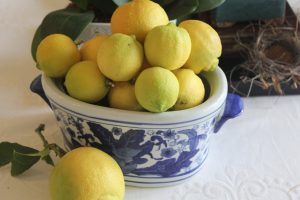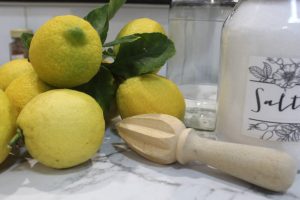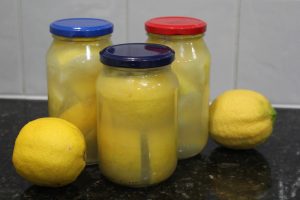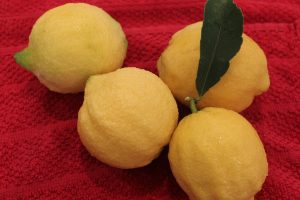preserving lemons


Are you a fan of lemons? I think almost everything I make is lemon scented or lemon flavoured at the moment. We have so many lemons! Today I am preserving lemons, so I’ve picked fresh ones, the jars are in the dishwasher and I’m about to start preparing the brine. The size of your jar dictates how many lemons you will need.
sterilizing the jars
I’ve listed three common methods for sterilising jars. For each method you begin by washing the jars in hot soapy water, rinse but don’t towel dry. I wash them in the dishwasher although they have been stored after being cleaned previously.
1. Set the oven to 110°C, place the jars on an oven tray, place in the oven for 15 minutes, carefully remove and leave to cool.
2.Alternatively if you have a pot deep enough you can set the washed jars in it, cover with water and boil for 10 minutes. Remove carefully and leave to cool.
3. Or you could place washed jars in the microwave on high for 1 minute. Remove carefully and allow to cool. This is how I sterilised the jars when they came out of the dishwasher.

Preserved lemons are pickled in their own juice and salt for three weeks. Originating in Morocco and Middle Eastern recipes I find a little preserved lemon adds zing to everything from salads to stews. Select and sterilise the jar you want to use to preserve your lemons. A wide opening makes it easy to insert them. Cut off the tops and bottoms of each lemon after you have washed and dried them. Then cut your lemons into quarters leaving them joined at the base. Spoon two dessert spoons of salt into the jar and spoon more salt into the first lemon. Place it in the bottom of the jar.


Continue adding salted lemons, squashing them down and releasing juice. Finally, when the jar is full of salted lemons top up with extra lemon juice.
Leave in the fridge for four weeks before adding to salads, soups, stews and casseroles, or whatever takes your fancy! I turn the jars every few days during the process. Be sure to scrape the pulp from the skin before using the preserved lemon.


rats
Back in 1962 an experimental psychologist John Calhoun published an article in the Scientific American, after considerable research, on rat behaviour in growing populations. He observed that growing populations with increasing physical proximity induced stress and that the birth rate then decreased to reduce crowding.
However when he increased physical proximity by reducing rats personal space all sorts of other behaviours were triggered. Violence and homosexuality rocketed, females ceased to nurture and suckle their young which were then eaten by male rats. Some adults survived by avoiding social contact and spent their time grooming themselves. The population collapsed. The survivors with few social skills lived passively alone.
In another experiment rats in a closed environment were never allowed to become ill or run out of food. Once they reached a certain population density vice wiped them out. Food for thought when you consider the pressure in Australia for people to adopt tower block living in apartments in preference to our traditional way of life of living in separate houses on separate blocks of land. We are not exactly running out of room, are we? Points to ponder!
Taken from a book review in the Spectator of a book written by Lee Dugatkin’s, Dr Calhoun’s Mousery; The Strange Tale of a Celebrated Scientist, a Rodent Dystopia, and the Future of Humanity, published October, 2024.
